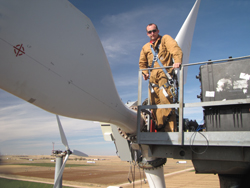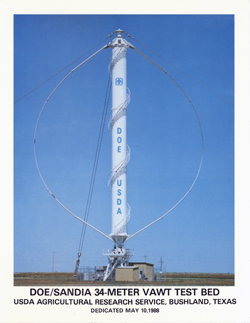
Project lead Jon White will oversee the installation of turbines at the new Lubbock site. (Photo by Mark Rumsey) Click on the thumbnail for a high-resolution image.
ALBUQUERQUE, N.M. – Sandia is moving its wind energy test facility to a new location near the campus of Texas Tech University in Lubbock.
Sandia, Texas Tech, and Group NIRE are pursuing a three-way research agreement under which this facility will operate. The Department of Energy’s Wind & Water Power program is funding Sandia’s work.
The site will perform primarily experimental work in turbine-to-turbine interactions and will evaluate innovative rotor technologies. It will also investigate such areas as aero-acoustics, aero-elasticity and structural health monitoring using embedded sensor systems.
“Wind flows into a turbine, and we understand how the turbine responds,” said Sandia project lead Jon White. “But what we aren’t as clear on is what happens to the wind as it leaves that turbine and moves to the next turbine.”
“We don’t have a great deal of clarity about how wind turbines interact with each other,” he continued. “Once you understand that, you can better optimize performance for an entire wind farm rather than just focusing on optimizing individual turbines.”
Researchers will also continue work on the structural mechanical adaptive rotor technology (SMART) rotor program at the Lubbock site. “Most wind turbine rotors today are passive structures. Sandia’s SMART rotors have active surfaces similar to airplane wings, with actuators that change their shape, allowing for greater control and flexibility,” said White.
The Lubbock site will include an initial installation of two wind turbines and three anemometer towers, with the potential to expand to nine or more wind turbines, which will allow researchers to examine how individual turbines and whole wind farms can become better ‘citizens of the grid’ and how they can be more productive and collaborative, said White.
Selecting a location was not easy, said Dave Minster, manager of Sandia’s wind energy technologies group.
Potential wind farm and wind research sites fall into classes of one through five, with class five winds being the preferred wind for research and for harvesting energy. However, only a small percentage of available sites are class five. Winds vary year-round and change seasonally, Minster said, so the site needed to be carefully characterized to ensure year-round quality wind for rapid evaluation of technologies.
But a great facility takes more than wind.
“We looked for a location that not only had a great wind resource, but also had a true commitment to wind energy; the partnership with Texas Tech does just that,” White said.
The Texas Tech University Wind Science and Engineering (WISE) center, located at Reese Technology Center, offers the collaboration a 35-year history in wind science research.
“WISE has strong academic program from which to draw faculty and students, and significant facilities that include a 200 meter anemometer tower, a 9,000-square-foot assembly building and a class 5 (very energetic) wind site,” White said.
Another partner, Group NIRE, will provide direct pathways for technology transfer to industry.
“With its other partners, Group NIRE will install additional megawatt-scale wind turbines at an adjacent site for testing and collaboration,” White said.
Sandia’s wind energy program has shared an instrumental partnership for more than 35 years with the Department of Agriculture’s (USDA) large research facility in Bushland, Texas. Much of Sandia’s wind testing has taken place at the Bushland site, from the early days of vertical axis wind turbines to today’s work on sensors and smart rotors. Given the research needs of the industry, however, Sandia and the U.S.D.A agreed that a different location was in the best interest of both organizations.
“The Lubbock site will continue the tradition of evaluating the next generation technology, such as SMART rotor, operational load monitoring and structural health monitoring technologies which seek to improve energy capture and reduce operations and maintenance costs,” said Minster. “These national test beds expand the nation’s knowledge base and capability in the design and advancements of composite wind turbine blades and turbine reliability, in order to reduce the cost of wind energy.”
Minster expects work at the Lubbock facility to begin by fall of this year.
Texas Tech University is home to more than 31,600 undergraduate and graduate students. Texas Tech is a comprehensive higher education institution providing education in a wide variety of disciplines ranging from the arts to the sciences. Texas Tech has an internationally recognized wind engineering program with a 67-acre research facility. For more information about the university, go to www.ttu.edu.
Group NIRE is a clean energy company providing project development, finance and consulting services. Group NIRE is currently developing wind projects in six states and working with several international renewable energy component manufacturers to commercialize new products and technologies. For more information about NIRE, contact Mark Harral, director of commercial development, at 806-771-7722.
Sandia National Laboratories is a multiprogram laboratory operated by Sandia Corporation, a wholly owned subsidiary of Lockheed Martin Corporation, for the U.S. Department of Energy’s National Nuclear Security Administration. With main facilities in Albuquerque, N.M., and Livermore, Calif., Sandia has major R&D responsibilities in national security, energy and environmental technologies, and economic competitiveness.
Sandia news media contact: Stephanie Holinka, slholin@sandia.gov, 505-284-9227
